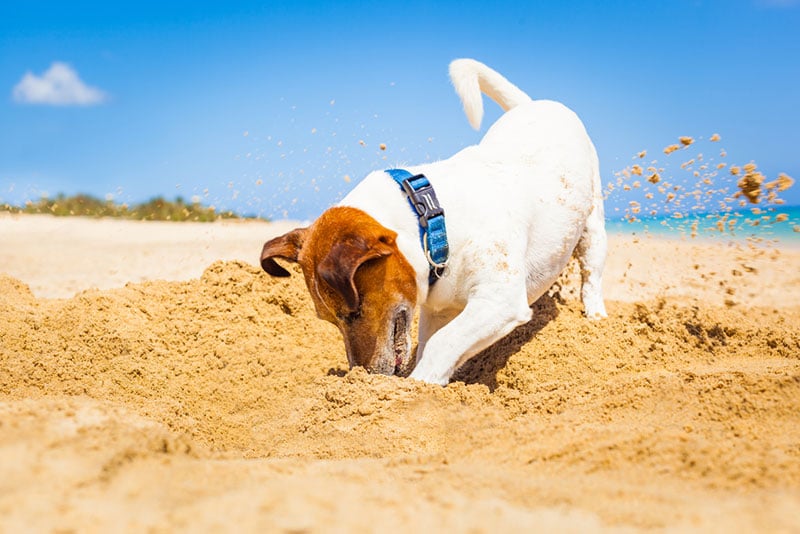Beach Safety Tips for Dogs

Summer’s almost here, and for many pet owners, that means packing up the car and heading off to enjoy a few days at the beach. Sunscreen? Check! Beach chairs? Check! Rover? Before you check your faithful friend off the list as well, take a minute to review some beach tips that will make the visit more enjoyable for you, for your dog, and for those around you.
First, before you load your dog in the car, make sure to find out if you can bring your dog with you to the beach. Some public beaches won’t allow pets, or may restrict which parts of the beach they can go to. And be sure that your hotel or condo allows pets (never assume!)
Once you get the green light to bring good ol’ Rover along, add a few things to your beach bag before leaving home. Pack a small bottle of vinegar if you plan on letting him or her go in the ocean. Dogs can fall victim to sea lice, or worse, jellyfish. If your dog should suffer a sting, douse the affected area in vinegar to ease the pain and kill off the stinging barbs before trying to remove the tentacles. Also, check with lifeguards about how strong the tides are, as well as any potential hazards lurking underwater that could injure your pet, including seaweed and rocks.
Be sure that some bottled water and a portable water bowl makes its way into the beach gear. While the ocean water may seem like a good source for drinking water, allowing your dog to drink the salt water can cause serious health issues. Dogs don’t have the ability to process large amounts of salt, so it builds up in their bodies and can make them very sick, or even prove fatal. This is especially true if the dog is older, very young, or has other health conditions. Remember to leave room on the beach towel for them to rest in the shade to avoid becoming overheated—after all, even a trimmed fur coat gets hot.
Finally, remember to make sure your dog has the proper identification tags. Because you’re in a new and exciting area with your four legged pooch, it is possible that they could wander too far when you’re distracted. Because they are unfamiliar with the territory, it is easy for them to get lost. Make sure to have a collar with ID tags at a minimum. But because tags can get lost, be sure you have your dog microchipped as well. Most vets and animal shelters can scan dogs who have been microchipped to access their owner’s contact info.
While you’re slathering yourself in sunscreen, don’t forget to put some on your pooch as well. Dogs are prone to sunburn just like humans, particularly those breeds that have short hair, white fur, and pink skin. Even dogs that have a lot of fur can still burn on their noses and ears, so try to keep your pet under cover or in the shade when the sun is at its hottest, and apply sunscreen to the nose, ears, and body at least half an hour before going outside. Another area that is often overlooked is the paws. If the sand is too hot for your feet, chances are it’s also hot enough to burn your dog’s paw pads. Shards of rock, shells, and debris such as broken bottles also pose a risk to your pet’s paws. If possible, bring some kind of paw protection. If a cut does occur, the bleeding can usually be stopped by applying pressure to the area. While larger and deeper cuts may need to be wrapped, immediate veterinary care is highly recommended.
Once you arrive at the beach, make sure that your dog is on their leash before you get out of the car. Not only will this ensure that your pet is safe, it could save you a lot of money as well due to local leash laws. Be sure that you don’t let your dog wander into other beach goers areas, especially after a swim, and have your dog sit when approached, so that they can be introduced to children and others who may want to pet or play with them. Keep an eye on the play to ensure that your dog doesn’t get overly excited or afraid.
Before you and your dog take the plunge into the ocean, take your dog to a calmer area, if there is one, and assess how well they can actually swim. Keep a close eye on your dog in case exhaustion begins to set in, either in the water or while running along the sand. There are also life jackets which are made just for dogs for additional protection. Needless to say, be sure to keep close watch on your dog while in and around the water.
While enjoying your day out, it is more than likely that nature will call, and your dog will have to answer. This is where responsible dog ownership comes in; you are responsible for making sure that your dog’s waste is cleaned up. Most public beaches have trashcans and you can either purchase small bags for clearing up waste, or use the ones you get from the grocery stores and other shopping excursions. A simple knot tied in the bag should be enough to keep the smell down.
After a fun day at the beach, remember to rinse your dog off well before heading back to the car, as salt and other minerals in sea water can damage their coat. Be sure to give the insides of the ears a quick wipe to remove excess water. This will help to prevent ear infections from setting in.
By following these simple tips, not only will you and your pet enjoy your day out, you’ll be welcomed back by your fellow beach goers.
Share This Post
Recent Posts
About Shallowford Animal Hospital
Shallowford Animal Hospital and The Pet Spa at Shallowford are dedicated to the exceptional, compassionate care your pet deserves. Pets hold a very special place in our families, and we treat yours like our own.



